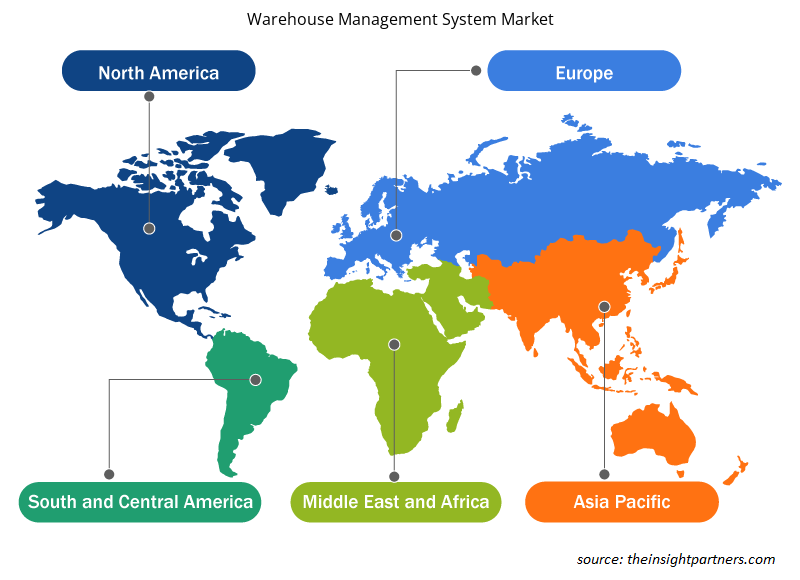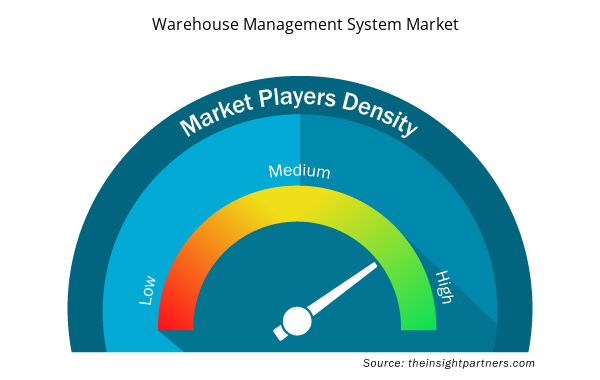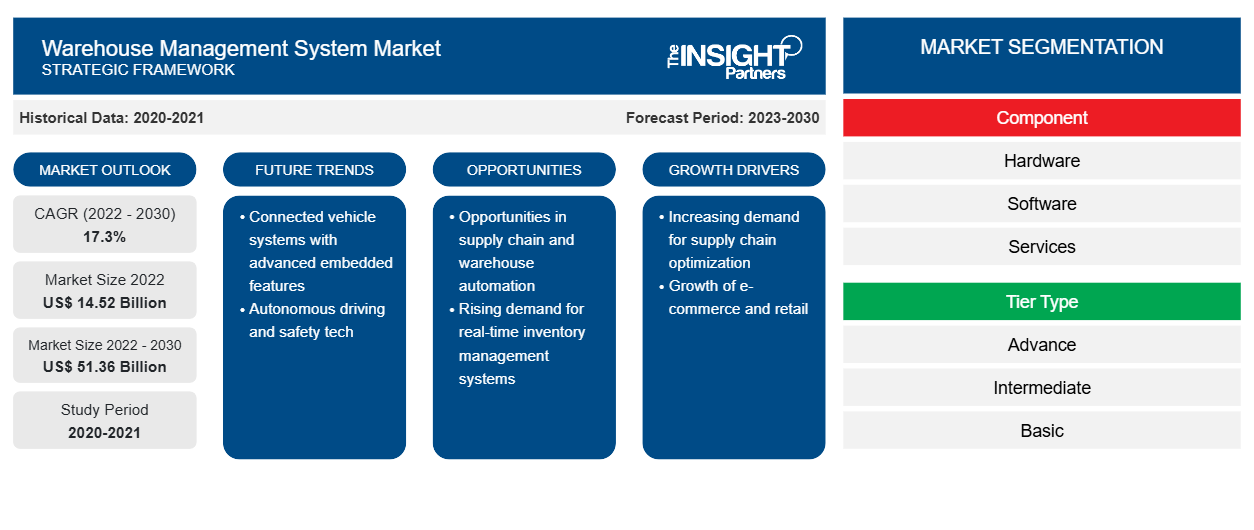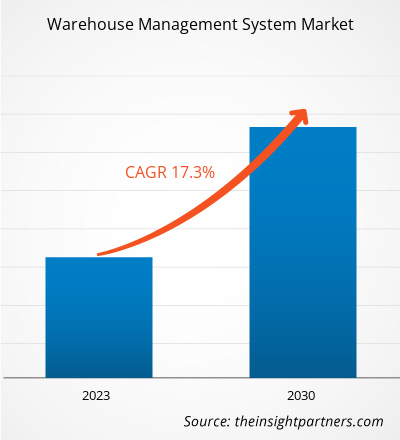من المتوقع أن ينمو سوق نظام إدارة المستودعات من 14،517.07 مليون دولار أمريكي في عام 2022 إلى 51،360.23 مليون دولار أمريكي بحلول عام 2030؛ ومن المتوقع أن يسجل معدل نمو سنوي مركب بنسبة 17.3٪ من عام 2023 إلى عام 2030.
تقدم العديد من الشركات تقنية الروبوتات لتحسين إدارة المخزون، خاصة بعد ظهور جائحة كوفيد-19. يقلل تطبيق تقنية الروبوتات من تكاليف العمالة، ويوفر تدفقًا أكثر كفاءة ودقة للعمليات، ويمكن للروبوتات العمل على مدار الساعة طوال أيام الأسبوع بنفس التكلفة. بالإضافة إلى ذلك، ساعدت تقنية الروبوتات المدمجة مع الذكاء الاصطناعي وإنترنت الأشياء الشركات على تحسين أتمتة المستودعات. مع دمج تقنية الروبوتات ونظام إدارة المستودعات، يتم تغذية الروبوتات ببيانات المخزون، مما يساعدها على أداء عمليات المستودعات بدقة وكفاءة. مثل هذه الفوائد تغذي نمو سوق نظام إدارة المستودعات.
تستخدم المستودعات الروبوتات لأداء مهام بسيطة ومتكررة، وخاصة في الصناعات مثل التصنيع وتجارة التجزئة والتجارة الإلكترونية. وبسبب تفضيلات المستهلكين المتغيرة أثناء جائحة كوفيد-19، تبنت المستودعات في جميع الأحجام بشكل متزايد الأتمتة للحفاظ على التباعد الاجتماعي وتقليل عدد الموظفين الذين يعملون من المنشأة. بالإضافة إلى ذلك، تُستخدم الروبوتات على نطاق واسع لأداء مهام للعمال مثل قياس درجات الحرارة وإدارة مطهر اليدين. كما قام العديد من خبراء الخدمات اللوجستية بتحويل عملياتهم اليدوية إلى الأتمتة. تتقدم تكنولوجيا روبوتات المستودعات بسرعة؛ على سبيل المثال، يمكن للروبوتات التنقل في المستودع بشكل مستقل. بالإضافة إلى النقل بالجملة للبضائع، يمكن للروبوتات اختيار وتعبئة وتكديس العناصر، مما يبسط العمليات المتعلقة بالمستودعات. علاوة على ذلك، أدت الشعبية المتزايدة للتجارة الإلكترونية إلى تسريع الطلب على الروبوتات عبر أنظمة إدارة المستودعات. مع العدد المتزايد من الطلبات عبر الإنترنت والطلب المتزايد على الشحن السريع، تستفيد المستودعات ومراكز التنفيذ من الأنظمة الروبوتية لتحسين إكمال الطلبات وإدارة المخزون بشكل أفضل. يتزايد الطلب على أنظمة الأجهزة الروبوتية، مما يساعد على تقليل الوقت والموارد التي يتم إنفاقها على استرجاع ونقل العناصر حول أرضية المستودع. يسمح النظام للعمال بالتركيز على العمليات الأكثر تعقيدًا مثل تعبئة وشحن الطلبات.
قم بتخصيص هذا التقرير ليناسب متطلباتك
ستحصل على تخصيص لأي تقرير - مجانًا - بما في ذلك أجزاء من هذا التقرير، أو تحليل على مستوى الدولة، وحزمة بيانات Excel، بالإضافة إلى الاستفادة من العروض والخصومات الرائعة للشركات الناشئة والجامعات
- احصل على أهم اتجاهات السوق الرئيسية لهذا التقرير.ستتضمن هذه العينة المجانية تحليلاً للبيانات، بدءًا من اتجاهات السوق وحتى التقديرات والتوقعات.
سوق نظام إدارة المستودعات -
تأثير جائحة COVID-19 على نمو سوق أنظمة إدارة المستودعات في أوروبا
في أوروبا، أدى توقيت ودرجة الاستجابة من قبل البلدان المختلفة لجائحة كوفيد-19، متبوعًا بإعادة تشغيل الاقتصادات تدريجيًا، إلى تأثير سلبي على سوق نظام إدارة المستودعات في المنطقة. عانى اللاعبون البارزون في سوق نظام إدارة المستودعات الأوروبية من انخفاض كبير في توقعات الإيرادات حيث تعطلت سلسلة التوريد بسبب قيود الاستيراد والتصدير. بالإضافة إلى ذلك، أثر إغلاق التصنيع والإنتاج في المساحات التجارية، وخاصة خلال المرحلة الأولية من الوباء، سلبًا على السوق في المنطقة. تتبنى العديد من القطاعات الرأسية، مثل التصنيع وتجارة التجزئة والتجارة الإلكترونية والسيارات، عروض نظام إدارة المستودعات حيث ينتقل المستهلكون بسرعة إلى منصات الإنترنت. بالإضافة إلى ذلك، هناك ارتفاع في الطلب على الأطعمة والمشروبات عبر الإنترنت، والأساسيات، والوصفات الطبية - مما يزيد من متطلبات التخزين.
تفتح العديد من الشركات الكبرى مستودعات في العديد من البلدان لتلبية الطلب المتزايد على حلول إدارة المستودعات. ونتيجة لذلك، أصبحت أنظمة إدارة المستودعات أكثر شعبية في شركات التجارة الإلكترونية والخدمات اللوجستية التابعة لجهات خارجية. ومن المتوقع أن تستمر شركات التجارة الإلكترونية العملاقة مثل أمازون وآسوس وإيباي في دفع الطلب على أنظمة إدارة المستودعات مع إنشائها لمرافق جديدة في جميع أنحاء المنطقة. بالإضافة إلى ذلك، يتحسن الوضع بسبب انخفاض حالات الإصابة بفيروس كوفيد-19 في المنطقة، وتكتسب السوق سرعة وستتوسع طوال فترة التوقعات. لذلك، من المتوقع أن يرتفع نمو سوق أنظمة إدارة المستودعات بشكل كبير بعد كوفيد-19.
رؤى السوق – سوق نظام إدارة المستودعات
شبكات سلسلة التوريد العالمية المتطورة
إن وضع السبب والنتيجة في شبكة سلسلة التوريد واضح نسبيًا. تتمتع المنظمات بتوزيع جغرافي أكبر داخل شبكة المستودعات الخاصة بها، مما يضيف طبقة من التعقيد فيما يتعلق بالإدارة. كما أن إدارة سلسلة التوريد عبر الحدود تقدم أيضًا تعقيدًا تنظيميًا وتوطينيًا يجب التعامل معه، حيث يستخدم المستخدمون في بلدان مختلفة نفس الأنظمة الأساسية لإنجاز المهمة. علاوة على ذلك، يلعب WMS دورًا حاسمًا في مساعدة المنظمات على التعامل مع العبء اللوجستي الإضافي للعولمة. يمكن لحلول WMS الرائدة أن تأخذ هذا إلى مستوى آخر من خلال أدوات جمع البيانات والتكامل المتخصصة. في يناير 2023، أطلقت Crave InfoTech منتجًا جديدًا لإدارة المستودعات الموسعة (EWM) يسمى cEWM، والذي تم بناؤه باستخدام SAP BTP. إنه عبارة عن منصة متعددة تعمل على تبسيط عمليات المستودعات، سواء عبر الإنترنت أو دون الاتصال بالإنترنت. غالبًا ما تفقد التطبيقات التقليدية المنقولة عبر الإنترنت المستخدمة في المستودعات الاتصال ومعها جميع بيانات العملية، وبالتالي تصبح عنق زجاجة لسلسلة التوريد الإجمالية. يعالج تطبيق cEWM من Crave InfoTech هذه التحديات ويعمل بكفاءة دون اتصال بالإنترنت أو عبر الإنترنت، بغض النظر عن انقطاع الاتصال أثناء العملية. علاوة على ذلك، تهدف إدارة سلسلة التوريد إلى الحفاظ على تدفق مستمر للسلع، من جمع المواد الخام إلى التصنيع إلى توزيع المنتج النهائي.
الرؤى القائمة على المكونات – سوق أنظمة إدارة المستودعات
بناءً على المكون، يتم تقسيم حجم سوق نظام إدارة المستودعات إلى أجهزة وبرامج وخدمات. استحوذ قطاع الأجهزة على أكبر حصة من السوق في عام 2022.
تعمل مكونات الأجهزة في نظام إدارة المستودعات على تحسين سير عمل المستودعات من خلال تحليل أفضل استخدام لمساحة الأرضية بناءً على خصائص المهمة والمواد. يمكن للمستودع خفض نفقات التشغيل من خلال النظر في أفضل المواقع لتخزين المنتجات والمواد أو المعدات. يتيح تنفيذ أنظمة الأجهزة قدرات وميزات أساسية مثل تحديد موقع المخزون وتداخل المهام وتخطيط الموجات وتخصيص الطلبات وإدارة المخزون وحساب الدورة والاختيار والتجديد والتعبئة والشحن وإدارة العمالة وواجهات معدات مناولة المواد الآلية (MHE). أدى ظهور جائحة COVID-19 إلى تسريع التقدم نحو الأتمتة، وحتى مع ارتفاع معدلات البطالة، تم أتمتة عمليات المستودعات لتلبية الطلب المتزايد من العملاء.
يتم تقسيم سوق أنظمة إدارة المستودعات على أساس المكون ونوع الطبقة والصناعة والجغرافيا. بناءً على المكون، يتم تقسيم السوق إلى أجهزة وبرامج وخدمات. بناءً على نوع الطبقة، يتم تقسيم السوق إلى متقدم (الطبقة 1) ومتوسط (الطبقة 2) وأساسي (الطبقة 3). بناءً على الصناعة، يتم تقسيم سوق أنظمة إدارة المستودعات إلى التصنيع والسيارات والأغذية والمشروبات والكهرباء والإلكترونيات والرعاية الصحية وتجارة التجزئة والتجارة الإلكترونية وغيرها.
بناءً على الجغرافيا، يتم تقسيم حجم سوق نظام إدارة المستودعات بشكل أساسي إلى أمريكا الشمالية وأوروبا ومنطقة آسيا والمحيط الهادئ (APAC) والشرق الأوسط وأفريقيا (MEA) وأمريكا الجنوبية. في عام 2022، احتلت منطقة آسيا والمحيط الهادئ أكبر حصة في سوق نظام إدارة المستودعات ومن المتوقع أن تحتفظ بهيمنتها خلال فترة التوقعات. ومن المتوقع أيضًا أن تسجل المنطقة أعلى معدل نمو سنوي مركب في سوق نظام إدارة المستودعات العالمية خلال فترة التوقعات.
تعد شركة International Business Machines Corp، وSAP SE، وEpicor Software Corp، وSofteon Inc، وOracle Corp، وPanasonic Holdings Corp، وInfor Inc، وManhattan Associates Inc، وPTC Inc، وTecsys Inc من بين اللاعبين الرئيسيين في سوق أنظمة إدارة المستودعات.
رؤى إقليمية حول سوق أنظمة إدارة المستودعات
لقد قام المحللون في Insight Partners بشرح الاتجاهات والعوامل الإقليمية المؤثرة على سوق نظام إدارة المستودعات طوال فترة التوقعات بشكل شامل. يناقش هذا القسم أيضًا قطاعات سوق نظام إدارة المستودعات والجغرافيا في جميع أنحاء أمريكا الشمالية وأوروبا ومنطقة آسيا والمحيط الهادئ والشرق الأوسط وأفريقيا وأمريكا الجنوبية والوسطى.

- احصل على البيانات الإقليمية المحددة لسوق نظام إدارة المستودعات
نطاق تقرير سوق نظام إدارة المستودعات
| سمة التقرير | تفاصيل |
|---|---|
| حجم السوق في عام 2022 | 14.52 مليار دولار أمريكي |
| حجم السوق بحلول عام 2030 | 51.36 مليار دولار أمريكي |
| معدل النمو السنوي المركب العالمي (2022 - 2030) | 17.3% |
| البيانات التاريخية | 2020-2021 |
| فترة التنبؤ | 2023-2030 |
| القطاعات المغطاة | حسب المكون
|
| المناطق والدول المغطاة | أمريكا الشمالية
|
| قادة السوق وملفات تعريف الشركات الرئيسية |
|
كثافة اللاعبين في السوق: فهم تأثيرها على ديناميكيات الأعمال
يشهد سوق أنظمة إدارة المستودعات نموًا سريعًا، مدفوعًا بالطلب المتزايد من المستخدم النهائي بسبب عوامل مثل تفضيلات المستهلكين المتطورة والتقدم التكنولوجي والوعي المتزايد بفوائد المنتج. ومع ارتفاع الطلب، تعمل الشركات على توسيع عروضها والابتكار لتلبية احتياجات المستهلكين والاستفادة من الاتجاهات الناشئة، مما يؤدي إلى زيادة نمو السوق.
تشير كثافة اللاعبين في السوق إلى توزيع الشركات أو المؤسسات العاملة في سوق أو صناعة معينة. وهي تشير إلى عدد المنافسين (اللاعبين في السوق) الموجودين في مساحة سوق معينة نسبة إلى حجمها أو قيمتها السوقية الإجمالية.
الشركات الرئيسية العاملة في سوق نظام إدارة المستودعات هي:
- شركة باناسونيك
- شركة آي بي إم
- ساب اس اي
- شركة إبيكور للبرمجيات
- سوفتيون
إخلاء المسؤولية : الشركات المذكورة أعلاه ليست مرتبة بأي ترتيب معين.

- احصل على نظرة عامة على أهم اللاعبين الرئيسيين في سوق نظام إدارة المستودعات
يركز المشاركون في سوق أنظمة إدارة المستودعات على تطوير أنظمة متقدمة وفعالة. على سبيل المثال:
- في عام 2023، أعلنت شركة Tecsys عن كيفية تمكين حلها الخاص بتنفيذ طلبات التجارة الإلكترونية من المستودع داخل المستودع لتجار التجزئة والعلامات التجارية من تنفيذ طلبات التجارة الإلكترونية دون أي عيوب مع ترك نماذج البيع بالجملة والتوزيع الحالية والأنظمة القديمة سليمة.
- في عام 2022، أعلنت شركة Infor، وهي شركة متخصصة في الحوسبة السحابية، أن شركة Mooneh، وهي شركة تابعة لجهة خارجية تقدم خدمات التخزين والتوزيع اللوجستي وتعمل لصالح شركات الأدوية العالمية الرائدة، قد قامت بنشر نظام إدارة المستودعات Infor WMS. وبالإضافة إلى إنشاء عملية مستودعات فعّالة وكفؤة، يوفر الحل إمكانية تتبع المخزون بالكامل. وقد نجحت شركة SNS، وهي شركة رائدة في تقديم الاستشارات وتنفيذ البرامج لسلسلة التوريد، في تنفيذ المشروع.
- التحليل التاريخي (سنتان)، السنة الأساسية، التوقعات (7 سنوات) مع معدل النمو السنوي المركب
- تحليل PEST و SWOT
- حجم السوق والقيمة / الحجم - عالميًا وإقليميًا وقطريًا
- الصناعة والمنافسة
- مجموعة بيانات Excel


- Sweet Potato Market
- Pharmacovigilance and Drug Safety Software Market
- Mesotherapy Market
- Photo Editing Software Market
- Railway Braking System Market
- MEMS Foundry Market
- Diaper Packaging Machine Market
- Nuclear Decommissioning Services Market
- Redistribution Layer Material Market
- Blood Collection Devices Market

Report Coverage
Revenue forecast, Company Analysis, Industry landscape, Growth factors, and Trends

Segment Covered
This text is related
to segments covered.

Regional Scope
North America, Europe, Asia Pacific, Middle East & Africa, South & Central America

Country Scope
This text is related
to country scope.
الأسئلة الشائعة
The key driving factors impacting warehouse management system market growth includes:
1. Migration to Cloud-Based WMS
2. E-Commerce Industry Growth
3. Global Supply Chain Networks
The US, UK, Rest of APAC, Saudi Arabia, and Rest of SAM are the countries registering high growth rate during the forecast period.
APAC is the fastest-growing regional market in the global warehouse management system market between 2023-2030.
The global warehouse management system market was valued at US$ 14,517.07 Mn in 2022
The key players of warehouse management system market are encompassed with International Business Machines Corp, SAP SE, Epicor Software Corp, Softeon Inc, Oracle Corp, Panasonic Holdings Corp, Infor Inc, Manhattan Associates Inc, PTC Inc, and Tecsys Inc.
The hardware segment led the global warehouse management system market in 2022.
The List of Companies - Warehouse Management System Market
- Panasonic Corporation
- IBM Corporation
- SAP SE
- Epicor Software Corporation
- Softeon
- Infor
- Manhattan Associates
- PTC Inc.
- Tecsys, Inc.
- Oracle Corporation
The Insight Partners performs research in 4 major stages: Data Collection & Secondary Research, Primary Research, Data Analysis and Data Triangulation & Final Review.
- Data Collection and Secondary Research:
As a market research and consulting firm operating from a decade, we have published and advised several client across the globe. First step for any study will start with an assessment of currently available data and insights from existing reports. Further, historical and current market information is collected from Investor Presentations, Annual Reports, SEC Filings, etc., and other information related to company’s performance and market positioning are gathered from Paid Databases (Factiva, Hoovers, and Reuters) and various other publications available in public domain.
Several associations trade associates, technical forums, institutes, societies and organization are accessed to gain technical as well as market related insights through their publications such as research papers, blogs and press releases related to the studies are referred to get cues about the market. Further, white papers, journals, magazines, and other news articles published in last 3 years are scrutinized and analyzed to understand the current market trends.
- Primary Research:
The primarily interview analysis comprise of data obtained from industry participants interview and answers to survey questions gathered by in-house primary team.
For primary research, interviews are conducted with industry experts/CEOs/Marketing Managers/VPs/Subject Matter Experts from both demand and supply side to get a 360-degree view of the market. The primary team conducts several interviews based on the complexity of the markets to understand the various market trends and dynamics which makes research more credible and precise.
A typical research interview fulfils the following functions:
- Provides first-hand information on the market size, market trends, growth trends, competitive landscape, and outlook
- Validates and strengthens in-house secondary research findings
- Develops the analysis team’s expertise and market understanding
Primary research involves email interactions and telephone interviews for each market, category, segment, and sub-segment across geographies. The participants who typically take part in such a process include, but are not limited to:
- Industry participants: VPs, business development managers, market intelligence managers and national sales managers
- Outside experts: Valuation experts, research analysts and key opinion leaders specializing in the electronics and semiconductor industry.
Below is the breakup of our primary respondents by company, designation, and region:

Once we receive the confirmation from primary research sources or primary respondents, we finalize the base year market estimation and forecast the data as per the macroeconomic and microeconomic factors assessed during data collection.
- Data Analysis:
Once data is validated through both secondary as well as primary respondents, we finalize the market estimations by hypothesis formulation and factor analysis at regional and country level.
- Macro-Economic Factor Analysis:
We analyse macroeconomic indicators such the gross domestic product (GDP), increase in the demand for goods and services across industries, technological advancement, regional economic growth, governmental policies, the influence of COVID-19, PEST analysis, and other aspects. This analysis aids in setting benchmarks for various nations/regions and approximating market splits. Additionally, the general trend of the aforementioned components aid in determining the market's development possibilities.
- Country Level Data:
Various factors that are especially aligned to the country are taken into account to determine the market size for a certain area and country, including the presence of vendors, such as headquarters and offices, the country's GDP, demand patterns, and industry growth. To comprehend the market dynamics for the nation, a number of growth variables, inhibitors, application areas, and current market trends are researched. The aforementioned elements aid in determining the country's overall market's growth potential.
- Company Profile:
The “Table of Contents” is formulated by listing and analyzing more than 25 - 30 companies operating in the market ecosystem across geographies. However, we profile only 10 companies as a standard practice in our syndicate reports. These 10 companies comprise leading, emerging, and regional players. Nonetheless, our analysis is not restricted to the 10 listed companies, we also analyze other companies present in the market to develop a holistic view and understand the prevailing trends. The “Company Profiles” section in the report covers key facts, business description, products & services, financial information, SWOT analysis, and key developments. The financial information presented is extracted from the annual reports and official documents of the publicly listed companies. Upon collecting the information for the sections of respective companies, we verify them via various primary sources and then compile the data in respective company profiles. The company level information helps us in deriving the base number as well as in forecasting the market size.
- Developing Base Number:
Aggregation of sales statistics (2020-2022) and macro-economic factor, and other secondary and primary research insights are utilized to arrive at base number and related market shares for 2022. The data gaps are identified in this step and relevant market data is analyzed, collected from paid primary interviews or databases. On finalizing the base year market size, forecasts are developed on the basis of macro-economic, industry and market growth factors and company level analysis.
- Data Triangulation and Final Review:
The market findings and base year market size calculations are validated from supply as well as demand side. Demand side validations are based on macro-economic factor analysis and benchmarks for respective regions and countries. In case of supply side validations, revenues of major companies are estimated (in case not available) based on industry benchmark, approximate number of employees, product portfolio, and primary interviews revenues are gathered. Further revenue from target product/service segment is assessed to avoid overshooting of market statistics. In case of heavy deviations between supply and demand side values, all thes steps are repeated to achieve synchronization.
We follow an iterative model, wherein we share our research findings with Subject Matter Experts (SME’s) and Key Opinion Leaders (KOLs) until consensus view of the market is not formulated – this model negates any drastic deviation in the opinions of experts. Only validated and universally acceptable research findings are quoted in our reports.
We have important check points that we use to validate our research findings – which we call – data triangulation, where we validate the information, we generate from secondary sources with primary interviews and then we re-validate with our internal data bases and Subject matter experts. This comprehensive model enables us to deliver high quality, reliable data in shortest possible time.


 احصل على عينة مجانية لهذا التقرير
احصل على عينة مجانية لهذا التقرير